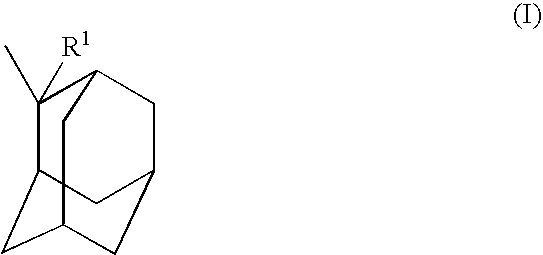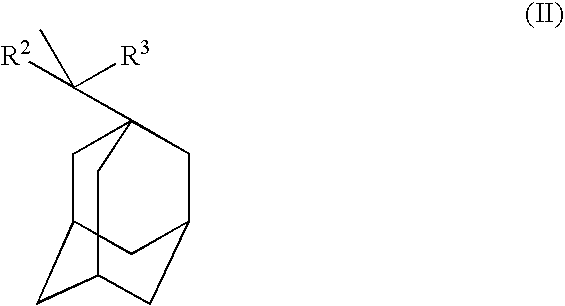Positive type resist composition and resist pattern formation method using same
a composition and resist technology, applied in the direction of photosensitive materials, instruments, auxiliaries/base layers of photosensitive materials, etc., can solve the problems of unsatisfactory resolution of the above problems, surface roughness appearing on the resist film following etching, and line edge roughness also appearing in the resist pattern, etc., to achieve excellent resolution, little surface roughness, and little line edge roughness
- Summary
- Abstract
- Description
- Claims
- Application Information
AI Technical Summary
Benefits of technology
Problems solved by technology
Method used
Image
Examples
example 1
[0149] A positive type resist composition was produced by dissolving a component (A), a component (B) and a component (D) uniformly in a component (C), all of which are described below.
[0150] Component (A): A mixed resin comprising 50 parts by mass of an acrylate ester based copolymer (mass average molecular weight: 14,000) formed from structural units x, y and z shown below (x=40 mol %, y=30 mol %, z=30 mol %),
and 50 parts by mass of a methacrylate ester based copolymer (mass average molecular weight: 10,000) formed from structural units p, q and l shown below (p=40 mol %, q=40 mol %, l=20 mol %).
[0151] Component (B): 3 parts by mass of triphenylsulfonium nonafluorobutanesulfonate
[0152] Component (C): A mixed solvent of 450 parts by mass of propylene glycol monomethyl ether acetate and 300 parts by mass of ethyl lactate.
[0153] Component (D): 0.2 parts by mass of triethanolamine.
[0154] Subsequently, this positive type resist composition was applied to the surface of a silic...
example 2
[0170] With the exception of altering the component (A) in the manner described below, a positive type resist composition was prepared, and pattern formation was conducted, in the same manner as Example 1.
[0171] Component (A): A mixed resin comprising a polymer (mass average molecular weight: 15,000) in which the structural units y and z within the acrylate ester based copolymer used in Example 1 were altered to 50 mol % and 20 mol % respectively, and the structural unit x was replaced with 30 mol % of a structural unit m shown below, and
[0172] a polymer (mass average molecular weight: 10,000) in which the structural unit q within the methacrylate ester based copolymer used in Example 1 was replaced with a structural unit n shown below. The proportions of the structural units p, n and l were the same as the proportions of the structural units p, q and l respectively used in Example 1.
[0173] As a result, a 130 mm line and space pattern (1:1) was formed with good shape, and the de...
example 3
[0176] With the exception of altering the component (A) in the manner described below, a positive type resist composition was prepared, and pattern formation was conducted, in the same manner as Example 1.
[0177] Component (A): A mixed resin comprising 50 parts by mass of the acrylate ester based copolymer used in Example 1 (mass average molecular weight: 14,000), and
[0178] 50 parts by mass of an acrylate ester / methacrylate ester copolymer (wherein the structural unit l in the methacrylate ester based copolymer of Example 1 was replaced with the same mol % of the corresponding acrylate ester derivative) (mass average molecular weight: 10,000).
[0179] As a result, a 130 nm line and space pattern (1:1) was formed with good shape, and the depth of focus range was 600 nm. Furthermore, determination of the 3□ value revealed a result of 5.9 nm.
[0180] Inspection for defects was also conducted in the same manner as Example 1, and revealed 0 defects.
[0181] Furthermore, evaluation of the s...
PUM
| Property | Measurement | Unit |
|---|---|---|
| mass % | aaaaa | aaaaa |
| irregularities | aaaaa | aaaaa |
| contrast | aaaaa | aaaaa |
Abstract
Description
Claims
Application Information
 Login to View More
Login to View More - R&D
- Intellectual Property
- Life Sciences
- Materials
- Tech Scout
- Unparalleled Data Quality
- Higher Quality Content
- 60% Fewer Hallucinations
Browse by: Latest US Patents, China's latest patents, Technical Efficacy Thesaurus, Application Domain, Technology Topic, Popular Technical Reports.
© 2025 PatSnap. All rights reserved.Legal|Privacy policy|Modern Slavery Act Transparency Statement|Sitemap|About US| Contact US: help@patsnap.com



